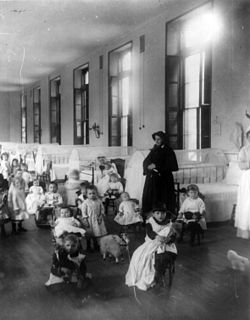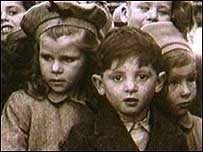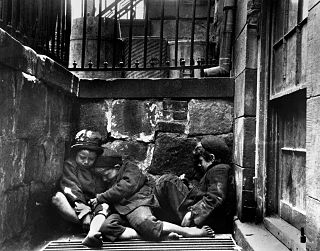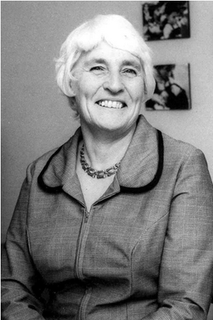
Adoption is a process whereby a person assumes the parenting of another, usually a child, from that person's biological or legal parent or parents. Legal adoptions permanently transfer all rights and responsibilities, along with filiation, from the biological parents to the adoptive parents.

Foster care is a system in which a minor has been placed into a ward, group home, or private home of a state-certified caregiver, referred to as a "foster parent" or with a family member approved by the state. The placement of the child is normally arranged through the government or a social service agency. The institution, group home, or foster parent is compensated for expenses unless with a family member. In some states, relative or "Kinship" caregivers of children who are wards of the state are provided with a financial stipend.
A behavior modification facility is a residential educational and treatment institution enrolling adolescents who are perceived as displaying antisocial behavior, in an attempt to alter their conduct.
Foster children in Canada are known as permanent wards. A ward is someone, in this case a child, placed under protection of a legal guardian and are the legal responsibility of the government. Census data from 2011 counted children in foster care for the first time, counting 47,885 children in care. The majority of foster children – 29,590, or about 62% – were aged 14 and under. The wards remain under the care of the government until they "age out of care." This age is different depending on the province.
Interracial adoption refers to the act of placing a child of one racial or ethnic group with adoptive parents of another racial or ethnic group.
Residential care refers to long-term care given to adults or children who stay in a residential setting rather than in their own home or family home.
Kinship care is a term used in the United States and Great Britain for the raising of children by grandparents, other extended family members, and adults with whom they have a close family-like relationship such as godparents and close family friends because biological parents are unable to do so for whatever reason. Legal custody of a child may or may not be involved, and the child may be related by blood, marriage, or adoption. This arrangement is also known as "kincare" or "relative care." Kinship placement may reduce the number of home placements children experience; allow children to maintain connections to communities, schools, and family members; and increase the likelihood of eventual reunification with birth parents. It is less costly to taxpayers than formal foster care and keeps many children out of the foster care system. "Grandfamily" is a recently coined term in the United States that refers to families engaged in kinship care.
Nancy Hazel was a Research Fellow with the School of Social Work at the University of Kent. In 1974, Hazel was part of a working group from the Council of Europe that published a report on child placement. The following year, she developed what became known as the Kent Family Placement Project (KFPP), the forerunner of all modern foster care across the United Kingdom.
Child protective services (CPS) is the name of a government agency in many states of the United States responsible for providing child protection, which includes responding to reports of child abuse or neglect. Some states use other names, often attempting to reflect more family-centered practices, such as department of children and family services (DCFS). CPS is also sometimes known by the name of department of social services, though these terms more often have a broader meaning.

A residential treatment center (RTC), sometimes called a rehab, is a live-in health care facility providing therapy for substance use disorders, mental illness, or other behavioral problems. Residential treatment may be considered the "last-ditch" approach to treating abnormal psychology or psychopathology.
The wraparound process is an intensive, individualized care management process for youths with serious or complex needs. Wraparound was initially developed in the 1980s as a means for maintaining youth with the most serious emotional and behavioral problems in their home and community. During the wraparound process, a team of individuals who are relevant to the well-being of the child or youth collaboratively develop an individualized plan of care, implement this plan, and evaluate success over time. The wraparound plan typically includes formal services and interventions, together with community services and interpersonal support and assistance provided by friends, kin, and other people drawn from the family's social networks. The team convenes frequently to measure the plan's components against relevant indicators of success. Plan components and strategies are revised when outcomes are not being achieved.
The Adolescent and Children's Trust (TACT) is the largest charity providing fostering and adoption services across the United Kingdom. The charity works in twelve offices across England, Wales and Scotland. As well as providing fostering or adoptive families for children, TACT campaigns on behalf of children and young people in care, carers, their families and adoptive families across the UK.
The Sixties Scoop was a period in which a series of policies were enacted in Canada that enabled child welfare authorities to take, or "scoop up," Indigenous children from their families and communities for placement in foster homes, from which they would be adopted by white families. Despite its name referencing the 1960s, the Sixties Scoop began in the mid-to-late 1950s and persisted into the 1980s.

Jack Tizard CBE was a research psychologist, professor of child development, research unit director, international adviser on learning disability and child care, and a president of the British Psychological Society. Tizard was born in New Zealand but spent most of his professional life in England where, as a psychologist, he worked at the boundaries of psychology, medicine, education and the social sciences. His work on alternatives to institutional care in the 1950s and 1960s underpinned the subsequent development of 'ordinary life' models for children and adults with learning disabilities. His later work focused on developing services for young children and their families. Tizard's approach was characterised by a commitment to using high research standards to address important social problems, ensuring through his extensive advisory activities that the results of research were available to practitioners and policy-makers.

Foster care is the term used for a system in which a minor who has been made a ward is placed in an institution, group home, or private home of a state certified caregiver. The placement of the child is usually arranged through the government or a social-service agency. The institution, group home or foster parent is provided compensation for expenses.
Life story work is a social work intervention with children and adults designed to recognise their past, present, and future. It is prominently used with children who will be adopted, and older adults as part of reminiscence therapies. Life story books are often incorporated into this work to give a visual aid and reminder of important events or feelings.
Residential child care communities or children's homes are a type of residential care, which refers to long-term care given to children who cannot stay in their birth family home. There are two different approaches towards residential care: The family model and the shift care model.
Out-of-home placements are an alternative form of care when children must be removed from their homes. Children who are placed out of the home differ in the types and severity of maltreatment experienced compared to children who remain in the home. One-half to two-thirds of youth have experienced a traumatic event leading to increased awareness and growing literature on the impact of trauma on youth. The most common reasons for out-of-home placements are due to physical or sexual abuse, violence, and neglect. Youth who are at risk in their own homes for abuse, neglect, or maltreatment, as well as youth with severe emotional and behavior issues, are placed out of the home with extended family and friends, foster care, or in residential facilities. Out-of-home placements aim to provide children with safety and stability. This temporary, safe environment allows youth to have their physical, mental, moral, and social needs met. However, these youth are in a vulnerable position for experiencing repeated abuse and neglect.

Joyce Robertson was a British psychiatric social worker, child behavioural researcher, childcare pioneer and pacifist, who was most notable for changing attitudes to the societally acceptable, institutionalised care and hospitalisation of young children, that was prevalent. In the late 1940s Robertson worked with Anna Freud first at the Well Baby Clinic and later in the Hampstead Child Therapy Clinic. She was later joined by her husband James Robertson. In 1965, both of them moved to the Tavistock Institute of Human Relations to work with John Bowlby on the Young Children in Brief Separation project and the development of attachment theory. This was to research the mental state and psychological development of children who underwent brief separation from their parents. Later in her career, Robertson worked with her husband to produce a series of celebrated documentary films that highlighted the reaction of small children who were separated from their parents. These were shown in hospitals, foster care and state run hospitals. Later she was known for promoting the idea of foster care instead of residential nurseries.
Prasanna Nair is an Indian-born doctor working in the United States. She works in primary health care with a specialty in pediatric endocrinology






